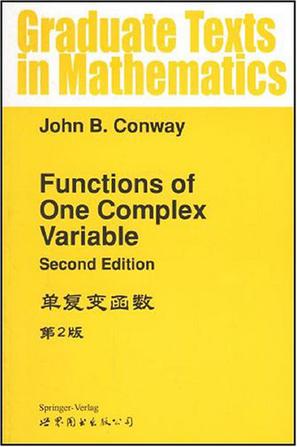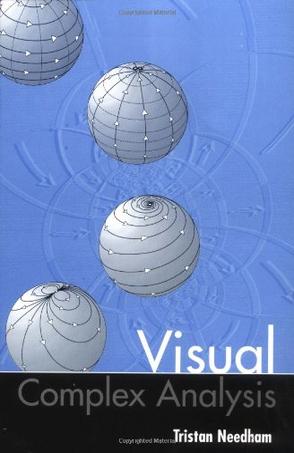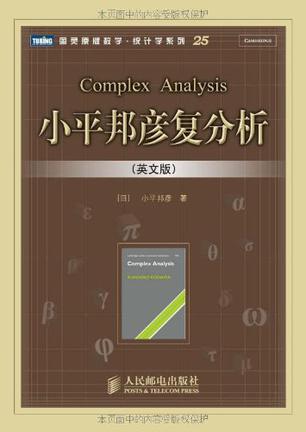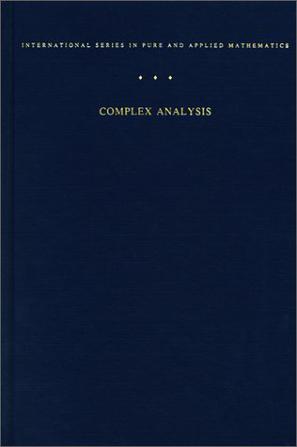-

复分析导引
本书是为综合性大学、高等师范院校数学专业本科高年级学生和研究生编写的复分析教材,其目的是讲述现代复分析(不含多复分析)的一些基本理论及其近代重要发展。 本书共分九章,主要内容有:正规族与Riemann映射定理,经典几何函数论,共形模与极值长度,拟共形映射,Riemann曲面的基本概念,Riemann-Roch定理与单值化定理,Teichmuller理论与模空间。这些内容与现代核心数学的许多分支领域有着深刻的联系。因此,本书不仅面向主修复分析的学生,而且也面向其他有关领域的学生。 本书是在作者多年来使用的讲义基础上编写而成,文字叙述简洁,通俗易懂,重点突出;特别注重解释重要概念和重要定理的意义以及方法的实质;部分定理的证明具有自己的明显特色。书中对一些重要理论的历史发展及其与其他领域的联系,作了必要的介绍与评述。 本书可作为高等院校高年级大学生、研究生的复分析教材,也可作为有关专业研究人员的参考书。 -

单复变函数 第2版
This book is intended as a textbook for a first course in the theory offunctions of one complex variable for students who are mathematicallymature enough to understand and execute arguments. The actual pre-requisites for reading this book are quite minimal; not much more than astiff course in basic calculus and a few facts about partial derivatives. Thetopics from advanced calculus that are used (e.g., Leibniz's rule for differ-entiating under the integral sign) are proved in detail. -

复分析导论(第一卷)
《复分析导论(第1卷)·单复变函数(第4版)》文字叙述极具特色,素材丰富,内容包括全纯函数及其性质、解析延拓、几何理论的基础、解析方法、调和与次调和函数等。《复分析导论(第1卷)·单复变函数(第4版)》可供高等学校数学、物理、力学及相关专业的本科生、研究生、教师,以及相关领域的研究人员参考使用。 复分析是研究复函数,特别是亚纯函数和复解析函数的数学理论,其应用领域极为广泛,在其他数学分支和物理学中均起着重要的作用。 《复分析导论》(二卷本)根据作者在莫斯科大学讲授的讲义编写而成,分别涉及复分析必修课程和专业基础课的基本内容。《复分析导论(第1卷)·单复变函数(第4版)》是第一卷,给出了单复变函数理论的基本概念的完整叙述,并从一开始引入高维复分析中的许多重要思想,并通过单变函数的内容加以解释,为第二卷讲述高维复分析的内容做了必要铺垫。书中配备许多问题和练习,并列举了许多应用例子,有助于读者的学习。 -

Visual Complex Analysis
Now available in paperback, this successful radical approach to complex analysis replaces the standard calculational arguments with new geometric ones. With several hundred diagrams, and far fewer prerequisites than usual, this is the first visual intuitive introduction to complex analysis. Although designed for use by undergraduates in mathematics and science, the novelty of the approach will also interest professional mathematicians. -

小平邦彦复分析
《小平邦彦复分析(英文版)》讲述了复变函数的经典理论。作者用易于理解的方式严密介绍基础理论,强调几何观点,避免了一些拓扑学难点。书中首先从拓扑上较简单的情形论证了柯西积分公式,并引出连续可微函数的基本性质。然后阐述共形映射、解析延拓、黎曼映射定理、黎曼面及其结构,以及闭黎曼面上的解析函数等。书中包含大量的图示和丰富的例子,并附有习题,可以帮助读者增强对课程的理解。 -

Complex Analysis
A standard source of information of functions of one complex variable, this text has retained its wide popularity in this field by being consistently rigorous without becoming needlessly concerned with advanced or overspecialized material. Difficult points have been clarified, the book has been reviewed for accuracy, and notations and terminology have been modernized. Chapter 2, Complex Functions, features a brief section on the change of length and area under conformal mapping, and much of Chapter 8, Global-Analytic Functions, has been rewritten in order to introduce readers to the terminology of germs and sheaves while still emphasizing that classical concepts are the backbone of the theory. Chapter 4, Complex Integration, now includes a new and simpler proof of the general form of Cauchy's theorem. There is a short section on the Riemann zeta function, showing the use of residues in a more exciting situation than in the computation of definite integrals.